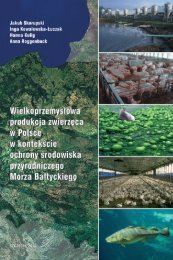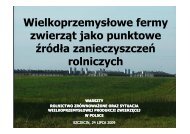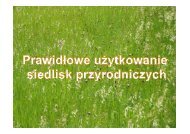best available technologies for manure treatment - Baltic Green Belt
best available technologies for manure treatment - Baltic Green Belt
best available technologies for manure treatment - Baltic Green Belt
You also want an ePaper? Increase the reach of your titles
YUMPU automatically turns print PDFs into web optimized ePapers that Google loves.
Best Available Technologies <strong>for</strong> <strong>manure</strong> <strong>treatment</strong> baltic sea 2020<br />
Best Available Techniques Technologies <strong>for</strong> <strong>manure</strong> <strong>for</strong> <strong>manure</strong> <strong>treatment</strong> <strong>treatment</strong> - <strong>for</strong> intensive rearing of pigs in <strong>Baltic</strong> Sea Region EU Member States Technical Report "Best Practice Manure Handling, baltic Phase sea 2020 2"<br />
ANNEX E: TABLES WITH SHORT DESPRIPTION OF LIVESTOCK MANURE TREATMENT TECHNOLOGIES<br />
Ref No. 17 Separation by drum filters<br />
Brief description<br />
Description of the effect on leaching (positive or negative) of N<br />
and P<br />
Drum sieve: The principle is an app. 4 meters long drum, where the material is flowing through inside<br />
and the liquid is passing through the drum. Eventually the drum can be mounted with a fibre cloth on<br />
the outside to optimize the separation. The drum sieve has often lower capacity, but has fairly good<br />
separation efficiency in relation to a low investment.<br />
Drum sieve Content in fibre fraction<br />
Capacity (t/h) N P % of total volume % DM (dry matter)<br />
2 -3 20 % 30 - 55 % 25 - 27 % 12 %<br />
In case the livestock density in an area is the maximally allowed<br />
according the Nitrates Directive, the application of livestock<br />
<strong>manure</strong> would typically mean the double of the needs of the<br />
crops – especially concerning P. By exporting the fibre fraction to<br />
areas with a low livestock density, an over-fertilisation with P can<br />
be avoided, and thus a high degree of leaching of the excess P.<br />
According to N, the fibre fraction contains mainly (> 90%) of<br />
organic bounded N, which means that it is overall ammonium and<br />
nitrate (mineral N) that is left in the liquid part, and that means a<br />
substantial reduction in the potential leaching.<br />
Innovation stage<br />
Research<br />
Pilot<br />
Practice <br />
Major references<br />
1: Nielsen, 2008<br />
2: EU Commission,<br />
2003<br />
Investment price, <br />
Basic Variable<br />
~ 25.000 1,00 0,35<br />
Condition <strong>for</strong> leaching<br />
reduction effect<br />
Scenarios II – V<br />
Operational<br />
costs,<br />
per tonnes<br />
Certainty of in<strong>for</strong>mation<br />
Prices High<br />
Effect on<br />
leaching<br />
High<br />
per kg saved N<br />
or P leaching<br />
No data<br />
Complexity of implementation<br />
Low, there are several commercial plants/machines on the<br />
market, and is quite easily to install on the farm if the conditions<br />
at the farm are suitable concerning stable systems, storage tanks<br />
etc.<br />
Side 56<br />
55<br />
55








